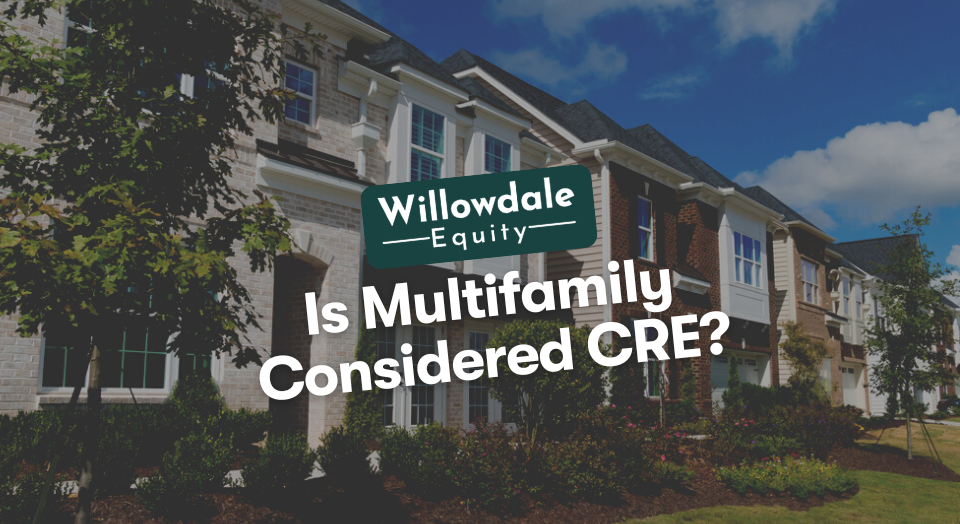
Is Multifamily Considered Commercial Real Estate?
This article is part of our passive investors guide on real estate syndications, available here.
Commercial and residential investments fall into two primary segments regarding multifamily properties. A commercial property with five or more units is considered multifamily. Two to four units make up the residential multifamily property. Each type of multifamily property has its benefits and drawbacks.
But are multifamily properties considered commercial or residential? We look to answer that directly in this post, as well as by explaining the different types of multifamily properties, comparing residential and commercial multifamily properties, and discussing how a residential rental operates vs. a multifamily community.
Key Takeaways
-
Multiple independent dwelling units housed in one building or several structures within one complex are classified as multifamily real estate. Multifamily buildings may be positioned next to one another or stacked one over the other.
-
A property with more than five units constitutes an investment in commercial property.
-
Up to four-unit duplexes are additionally frequently listed under a single deed. Consequently, duplexes are commonly regarded as residential homes even if they may house numerous renters.
Are Multifamily Properties Considered Commercial?
Multiple independent dwelling units housed in one building or several structures within one complex are classified as multifamily real estate. Multifamily buildings may be positioned next to one another or stacked one over the other.
So, a building with multiple housing units is referred to as a “multifamily property.” But are multifamily homes classified as residential or commercial properties?
Real estate classified as multifamily includes any single structure housing multiple tenants. But there is a clear difference between what counts as residential investment and what counts as commercial real estate (CRE) investment. And that difference has a significant impact on how purchases are funded.
Buildings with two to four units are residential buildings in multifamily real estate. Commercial real estate properties are structures (or collections of buildings) with five or more units. The difference between the two is in the deeds. A single deed covers residential property. Because of this, even if there are several condos or townhomes within the same building, they are still considered residential properties.
However, purchasing an apartment building (with more than five units) constitutes an investment in commercial property. Up to four-unit duplexes are additionally frequently listed under a single deed. Consequently, duplexes are commonly regarded as residential homes even if they may house numerous renters.
So, are some multifamily properties considered commercial while others are residential? The answer is a resounding yes. With that clear, we can discuss the different types of multifamily properties.
The Different Types of Multifamily Properties
Multifamily homes can be broadly divided into two categories: those with two to four units and those with five or more units.
- The acquisition is more straightforward for multifamily buildings with two to four units because they are considered residential properties. However, it restricts the revenue sources that can be generated.
- Multifamily properties with five units or more are categorized as commercial properties and are consequently more challenging to buy. However, there are more sources of revenue flowing in.
Owning multifamily commercial real estate is not suitable for everyone due to the investment required. However, recent years have witnessed high returns on multifamily CRE investments.
The following are some more common MFCR property types; however, there are many others.
- Apartment complexes with ten stories or more are considered high-rises. More than 100 units may be present in the structure. Big cities and downtown neighborhoods are common locations for them.
- Five to nine stories are included in mid-rise apartment buildings. Typically, they have between 30 and 100 units.
- One to four-level walk-up living areas, with 50 to 200 units, make up garden-style apartments. The suburbs are frequently where you can find apartments.
For investment purposes, MCFR properties are also divided into different asset classes. The general quality and state of the property serve as the basis for the asset class.
With the different types of multifamily properties discussed, it’s time to compare a residential and a commercial multifamily property.
Residential vs. Commercial Multi Family

The multifamily industry is sometimes included as a subset of the more significant commercial real estate sector. Other times, it is treated as a separate industry. We once believed that multifamily housing belonged exclusively to the commercial real estate market. But when we began to differentiate between the two, we noticed that not everyone seemed to believe there to be a clear-cut answer.
Since multifamily can be regarded as both residential and commercial real estate, which are mutually exclusive, there is disagreement over whether it should be included in the category of commercial real estate.
Let’s look at some fundamental distinctions between residential and commercial properties in a multifamily context.
A duplex comprising two residences or a small apartment complex with two to four units or dwellings can also be classified as residential multifamily property. Real estate that is residential multifamily is eligible for conventional finance as well as FHA or VA borrowing. You must obtain a traditional investment loan if you own four homes, and at least one of them is your principal residence.
Buildings with five or more units are still considered multifamily housing but are classified as commercial properties. Real estate for commercial multifamily purposes needs commercial finance, frequently offered by local banks, CMBS, government agencies like Fannie Mae or Freddie Mac, or private lending, to name a few.
On a single land, multifamily properties may have several buildings. As an illustration, if a lot has two facilities, each containing three distinct units, the total number of units is six, making the lot commercial.
Different buildings can sometimes be plotted on several lots. It can be an opportunity for you to purchase each building and the related property in separate real estate deals. If each lot contains fewer than four units, this can be regarded as two independent residential transactions.
With the differences between residential and commercial multifamily real estate, it’s time to look at how operating a residential rental differs from running a multifamily community.
Related Read: Off Market Commercial Properties
Operating a Residential Rental vs. a Multifamily Community
If the residents of a residential building contact you or the manager you designated for dealing with maintenance issues, you would pay for the repairs out of the rent you are receiving.
Simpler to maintain properties are generally those with two to four apartments. In other words, they have a low maintenance cost. However, the costs can account for a sizable amount of the property’s revenue.
Typically, properties with five or more units are more difficult to operate and need professional management. However, the scale of a more significant number of units spreads the risk of absorbing natural vacancy.
Each property type has benefits and drawbacks. Before making any selections, it’s critical to determine what you want for your portfolio.
Commercial multifamily has the disadvantage of having more management and investment costs, making it challenging for a single investor to benefit from this asset class fully. While purchasing residential multifamily properties is more straightforward, there are fewer opportunities for economies of scale, so it will require many more transactions to amass a sizable portfolio.
Frequently Asked Questions about Commercial Real Estate vs. Multifamily
Yes, a 6-plex is considered commercial. The CAP rate and Net Operating Income (NOI) determine the property value.
Garages, office buildings, warehouses, hospitals, farmland, hotels, multifamily housing structures, retail stores, and shopping malls are all examples of commercial property. To borrow money and taxes, a residential property with more than a specified number of units counts as commercial property in several jurisdictions.
Is Multifamily Considered Commercial – Conclusion
Suppose you want to make a comprehensive assessment. In that case, you must consider the differences in real estate investing criteria, pricing, and definitions in addition to express intent, which is vital in adequately distinguishing between commercial and residential multifamily properties.
Join the FREE 5-Day PASSIVE Real Estate Investing Crash Course to learn everything from A to Z about commercial multifamily real estate investing.
Interested In Learning More About PASSIVE Real Estate Investing In Multifamily Properties?
Get Access to the FREE 5 Day PASSIVE Real Estate Investing Crash Course.
In this video crash course, you’ll learn everything you need to know from A to Z
about passive investing in multifamily real estate.
We’ll cover topics like earned income vs passive income, the tax advantages, why multifamily, inflation, how syndications work, and much much more!




